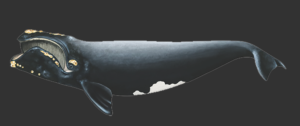Population trajectory is very simple, so simple a fourth-grader could calculate the formula, according to Center for Coastal Studies scientist Stormy Mayo.
Take the number of animals born and subtract the number that die, and you can determine whether a population is rising or falling.
If that number is negative, as it has been for 10 years for the North Atlantic right whale, the species is headed for extinction.
 After a decade of decline, the scientists who have spent years studying the whales and fishermen who have spent tens of thousands of dollars to work around the whales are asking: what more can be done?
After a decade of decline, the scientists who have spent years studying the whales and fishermen who have spent tens of thousands of dollars to work around the whales are asking: what more can be done?
The animal had been slowly recovering after centuries of overfishing decimated the population. In 2010, there were an estimated 500 right whales living in the North Atlantic. Now, scientists estimate there are about 400.
“We worry about endangered animals,” Mayo told the Independent, “but this one is really, really endangered.”
A ‘Wicked Hard’ Problem
Over the years, the waters around Cape Cod have been regulated by the state and federal governments in an attempt to protect the right whales’ falling population.
Certain areas around the Cape are closed to vertical line lobster fishing when the whales are in peak season. Restrictions reduce vessel speed to 10 knots to prevent strikes. Gear requirements prohibit the use of fishing apparatus that is more likely to entrap whales when they encounter it in the water.
When entanglements do happen, the Center for Coastal Studies has a 24/7 team ready to spring into action to save a whale.
In spite of all this, the whale population continues to fall. The Independent reported in March that female whales’ birth rates were down and mortality rates were up.
Richard Pace, a wildlife biologist at the Northeast Fisheries Science Center at Woods Hole, said if he could write a headline for the problem, it would be: “Stopping right whale decline is wicked hard.”
Pace worries that with different groups involved blaming each other — the vessel owners blaming the lobstermen, the fishermen in the U.S. blaming the ones in Canada, and vice versa — more reforms that would be needed won’t be implemented.
“There’s too much dependence on too many different people to do too many different things” to solve the problem, he said.
In early July, the International Union for the Conservation of Nature designated the right whale “critically endangered.”
Pace thinks food insecurity might be affecting the whales’ reproduction rates, but if the population was “not beat to hell from running into all this gear,” it wouldn’t be causing an extinction level trajectory, he said.
Starting out with such small numbers, he said, “whenever one of these threats, whether it’s vessels or fishing, kills one right whale, they’ve had a huge impact on the population.”
‘Doing Their Part’
On the other side of the line, many Cape Cod lobster fishermen don’t want to be a part of the problem but have found themselves tied up in environmental red tape.
Rob Martin, a lobsterman who lives in Sandwich and fishes in the waters around Cape Cod, has tried to get a jump start on fishing technology, testing and investing in gear that might be more whale friendly. This includes lines that break under a reduced weight, so that they won’t entangle a whale that encounters them, and gear that reduces the vertical lines running to the surface, to prevent whale-line encounters from happening all together.
Martin and other lobster fishermen have tried out new nontraditional gear to stay one step ahead of regulations so they can continue fishing without delays.
Not sure he’s winning the fight for whales, he says, “I’ll get a good conscience out of it anyways.”
“Everyone is doing their part,” Dana Pazolt, a lobster fisherman who works out of Provincetown, told the Independent.
Delayed start dates for spring fishing and expensive gear to accommodate regulations and prevent entanglements are parts of the job that Pazolt has come to terms with.
He rejects the fishermen-versus-whales narrative — fisherman don’t want to see whales die and the folks at the Center for Coastal studies are friends, not foes, who have worked with the lobstermen to come up with solutions, he said.
A Hotspot for Now
In peak season, from April to May, up to 65 percent of the entire North Atlantic right whale population visits the Cape Cod Bay — but that could change in the future.
“To have that many of a nearly extinct species whose habitat ostensibly spreads across the entire North Atlantic is weird, to be honest,” Mayo said. The bay hasn’t always been the most popular hotspot, he explained, and as the climate changes it won’t always be.
The whales’ choice of location is one of many phenomena that Mayo wants to study further. Among other things, Mayo also wants to learn more about the food the whales eat and how it’s affecting their population, as food quality appears to fluctuate with the calving rate in Cape Cod Bay.
“There are not only many layers,” Mayo added, “there are many, many unknowns.”
As long as the whales still choose the bay for their annual mass congregation, Mayo and his team at the Center for Coastal Studies will continue to watch and collect data that may help preserve the population. The fishermen will continue to work through the regulations the scientists have helped inform.
They will all be counting the whales.



